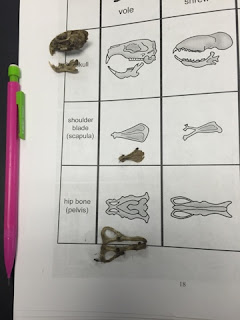In this lab I dissected an owl pellet, which is the remains that are not digestible enough to even pass through the whole owl. To tart off the lab I read a large packet on general information about owls, such as what kinds of animals they eat, what an owl pellet is, etc. Then I did a small hypothesis, based on prior knowledge, what I expected the differences to be with the human skeleton. I measured the mass , length, and width of the pellet. Then I started breaking up the pellet, separating the hair from the bones. I had a great array of bones which you can see in the photos below, I had the skull, ribs, scapula, some vertebrae, and majority of the lower extremities. I then measured the dimensions of the skull and lower jaw.
From my observations I concluded that the animal was a vole. Firstly, the molars were pointed, the skull length was 25mm, and the lower jaw was 20mm, which all the directly correspond with the standards of a vole. There is also striking similarity between the scapula, hip bone, tibia, fibula, and femur. (Shown in pictures below)
As for the comparison of the human skeleton to the rodent skeleton, the rodent's skeleton includes the 4 types of vertebrae much like a human, but also has an extra, the caudal vertebrae (tail bones). Human's have the coccyx which is a variation of that. Both have a scapula,which presume the same function, but the rodent's sticks out more instead of mainly being spread across the back like that of a human. The final similarity/ difference that I noticed was, while both have pelvises that attach to the femur, the pelvis of a rodent is much longer. A human's seems a lot wider and shorter by comparison, considering the rodent's is actually longer than its femur.






No comments:
Post a Comment